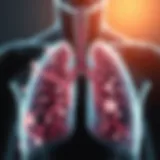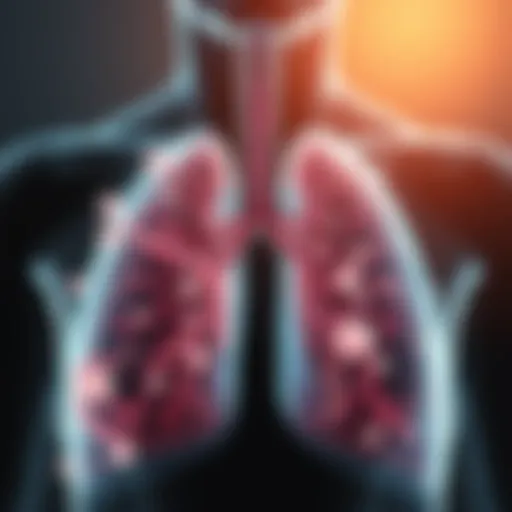Effective Strategies to Stop Ingrown Hairs on the Face


Intro
Ingrown hairs on the face are a common yet often overlooked issue that can affect both appearance and comfort. These conditions occur when hair follicles become clogged or damaged, causing hair to grow sideways into the skin instead of outward. Understanding the causes and implementing effective strategies to prevent and treat this condition is crucial in maintaining both physical health and mental well-being.
The process invites an exploration not only of grooming habits but also of skin health. By addressing the factors that contribute to ingrown hairs, individuals can enjoy a smoother complexion and reduce the risk of complications such as infections or scarring.
Key Benefits
Addressing ingrown hairs effectively has significant implications for overall health.
Physical Health Benefits
- Reduced Inflammation: Regularly treating and preventing ingrown hairs minimizes irritation and swelling of the skin.
- Lower Risk of Infection: Proper care reduces the likelihood of developing inflammatory lesions caused by blocked follicles.
- Enhanced Skin Texture: Consistent application of preventive measures leads to smoother skin and less noticeable hair regrowth.
Mental Well-being Enhancements
- Boosted Confidence: A clear complexion contributes to a person's self-esteem and overall mental health.
- Decreased Anxiety: Knowing how to manage skin issues alleviates worry about personal grooming and appearance.
"Effective grooming habits are more than just routines; they play a vital role in one’s self-image and mental state."
Practical Tips for Prevention and Treatment
Gentle Exfoliation
Exfoliating the skin lightly helps remove dead skin cells. This step is crucial as it aids in preventing the clogging of hair follicles. Use mild exfoliating products two to three times a week to maintain skin clarity without causing irritation.
Proper Shaving Techniques
- Use a New Blade: Old and dull blades increase the likelihood of irritation. Regularly replace blades to ensure a smooth shave.
- Shave in the Direction of Hair Growth: This technique helps reduce the chances of hairs being pushed back into the skin.
- Moisturize After Shaving: Applying a soothing aftershave balm or moisturizer can calm irritation and keep the skin hydrated.
Additional Remedies
- Topical Treatments: Use products containing salicylic acid or glycolic acid to dissolve dead skin and prevent ingrown hairs.
- Avoid Tight Clothing: Wearing tight clothing can irritate the skin, making ingrown hairs more likely. Opt for breathable fabrics whenever possible.
By adopting these strategies, individuals can significantly improve their skin health and alleviate the discomfort associated with ingrown hairs.
Further information and discussions on related health topics can be found on Wikipedia and Britannica.
Understanding Ingrown Hairs
Understanding ingrown hairs is crucial for effective management and prevention of this common skin issue. Ingrown hairs occur when hair grows back into the skin instead of exiting through the follicle. This can lead to painful bumps, inflammation, and even infections. By comprehending their nature, one can adopt strategies to minimize occurrences and deal with them promptly if they arise.
Definition of Ingrown Hairs
Ingrown hairs are hairs that curl back or grow sideways into the skin after being cut, shaved or waxed. They are often accompanied by redness and itchiness, as well as potential swelling. In some cases, they may present visibly as small, raised bumps that could resemble acne.
How Ingrown Hairs Develop
Various factors contribute to the development of ingrown hairs. Primarily, improper shaving techniques can result in sharp hair edges, which are more likely to stab back into the skin. Furthermore, the curliness of certain hair types can cause these hairs to grow back toward the skin, increasing the chance of becoming ingrown. Environmental influences like friction from clothing or skin products may also exacerbate the issue, making it vital to consider these variables.
Common Areas Affected on the Face
Ingrown hairs on the face are often found in areas that are routinely shaved or waxed. This includes the cheeks, chin, and jawline. Each of these areas is susceptible due to the nature of hair growth and the techniques employed during grooming. Recognizing where ingrown hairs commonly occur can empower individuals to take more tailored preventive measures.
"Effective awareness of ingrown hairs enables better management and reduced skin discomfort."
Awareness is the first step towards minimizing ingrown hairs effectively. Understanding their definition, development, and affected areas will guide individuals in adopting better grooming techniques, thus ensuring healthier skin.
Causes of Ingrown Hairs on the Face
Understanding the causes of ingrown hairs on the face is essential for effective prevention and treatment. This topic allows individuals to address the root of the problem rather than merely managing the symptoms. By identifying these causes, readers can adjust their grooming habits and skin care routines to minimize the risk of developing ingrown hairs.


Shaving Techniques
Shaving is one of the most common reasons for ingrown hairs. Using improper techniques can lead to hair being cut at an angle, making it more likely to grow back into the skin instead of outward. To minimize this risk, several techniques can be adopted:
- Shave in the direction of hair growth: Shaving against the grain might result in closer cuts, but this can push hair back into the skin.
- Use sharp blades: Dull blades can cause tugging and pulling of hair, leading to an uneven shave.
- Avoid shaving too frequently: Giving hair time to grow can reduce the chances of it curling back into the skin.
Applying these methods can significantly reduce the occurrence of ingrown hairs, promoting a healthier skin appearance.
Hair Type and Growth Direction
The nature of one’s hair plays a pivotal role in the development of ingrown hairs. Curly or coarse hair is more prone to becoming ingrown because of its natural growth patterns. When such hair grows, it can loop back into the skin, causing inflammation and discomfort. Some considerations include:
- Growth direction: Observing the natural growth direction of hairs can help in deciding how to shave effectively.
- Hair texture: Understanding whether your hair is straight, wavy, or curly can help tailor grooming techniques to avoid problems.
Making informed choices based on hair characteristics provides better outcomes and diminishes the chance of ingrown hairs.
Skin Conditions Increasing Risks
Certain skin conditions can heighten the chances of experiencing ingrown hairs on the face. Conditions like acne or eczema can cause changes in the skin's texture, making it rougher. This texture can trap hair and contribute to ingrowth. Moreover, consider factors such as:
- Inflammation: Inflammatory skin conditions can compromise the skin barrier.
- Oily skin: Excess oil can clog pores, further trapping hair.
Recognizing these underlying skin conditions can prompt individuals to seek targeted treatments, therefore reducing the risk of ingrown hairs. Ultimately, being aware and proactive about these causes can lead to smoother skin and enhanced comfort.
Preventive Measures
Preventive measures are crucial in managing and reducing the occurrence of ingrown hairs on the face. By adopting effective strategies, individuals can not only minimize their discomfort but also improve their skin health overall. Prevention is typically more efficient than treatment, and this philosophy holds especially true for the issue of ingrown hairs. This section addresses specific elements and considerations that enhance preventive practices.
Proper Shaving Techniques
Using appropriate shaving techniques is vital in preventing ingrown hairs. A sharp razor is essential; dull blades tug on the hair rather than cutting it cleanly, leading to irregular growth patterns that can contribute to ingrown hairs. Additionally, always shave in the direction of hair growth. Shaving against the grain may result in hair being cut too short, increasing the likelihood that it will curl back into the skin.
Another critical aspect is the preparation of the skin before shaving. This can involve softening the whiskers with warm water and employing shaving creams that provide a protective barrier. For people with sensitive skin, using a shaving gel with soothing ingredients can be beneficial. It's also advisable to limit the frequency of shaving, as this may reduce skin irritation.
Exfoliation Practices
Regular exfoliation is an important practice to deter the development of ingrown hairs. By consistently removing dead skin cells, you help to keep the hair follicles clear. This process allows hair to grow freely without being trapped below the surface. Exfoliating can be done using physical methods, such as scrubs, or chemical methods, such as alpha-hydroxy acids, or salicylic acid.
Exfoliating at least twice a week is generally recommended. Individuals should choose products based on their skin type, as overly aggressive scrubs can exacerbate irritation. Incorporating a gentle approach in exfoliation not only helps prevent ingrown hairs but also promotes a smoother skin texture, improving overall appearance.
Moisturizing the Skin
Keeping the skin well-moisturized is another key preventive measure. Dry skin can lead to built-up dead skin cells, which can cause hair to become trapped. A good moisturizer should be suitable for facial use and ideally non-comedogenic, as this ensures it does not clog pores. Ingredients such as hyaluronic acid, shea butter, or glycerin deliver hydration effectively.
Daily hydration can be particularly important after shaving or exfoliation. This helps to soothe any potential irritation and supports the skin’s natural barrier. Moisturizing should be done consistently in both morning and evening routines to maintain optimal skin health.
Choosing the Right Products
Selecting appropriate grooming products is essential for preventing ingrown hairs. This involves not only the razor blades and shaving creams but also aftershaves and moisturizers. Look for products specifically designed for sensitive skin or marked as anti-ingrown hair formulas. Avoid items with alcohol or fragrances that can lead to irritation.
When considering shaving tools, options such as electric shavers or safety razors might be better for some individuals. They can provide a closer shave while reducing irritation risk. Ensure any products chosen align with one’s skin type and individual needs.
"An informed approach to skincare is the best preventive strategy against ingrown hairs and skin irritation."
By following these preventive measures, individuals significantly decrease the risks of developing ingrown hairs on the face. The combination of proper shaving techniques, effective exfoliation practices, consistent moisturizing, and selecting suitable products form a comprehensive defense strategy, leading to healthier, smoother skin.
Identifying Ingrown Hairs
Identifying ingrown hairs is crucial for those concerned with facial grooming and skincare. Recognizing the signs early can prevent both discomfort and potential infections. Understanding how to spot ingrown hairs increases awareness about one's skin health, aiding in the selection of effective treatment strategies. When ingrown hairs are identified promptly, it can save time and money spent on trying various remedies or professional treatments.
An ingrown hair occurs when a hair grows back into the skin instead of emerging from the follicle. This can lead to irritation, inflammation, and possibly infection. Becoming familiar with common symptoms can help in recognizing ingrown hairs before they escalate into more severe skin issues.
Symptoms to Recognize


The symptoms of ingrown hairs can vary, but there are a few key indicators that one can look for:
- Red bumps: These often appear where the hair has grown into the skin. They may resemble small pimples and can be itchy or tender.
- Pain or irritation: There may be discomfort in the area, particularly when pressure is applied.
- Pus or fluid: If a bump becomes infected, it may produce pus, indicating a need for more focused treatment.
- Visible hair: Sometimes, you can see the hair trapped under the skin's surface, curled or angled, which signifies an ingrown hair.
It is essential to monitor these symptoms. Early detection often means simpler and more effective treatment options, as opposed to dealing with secondary effects such as scarring or persistent inflammation.
When to Seek Medical Attention
While many ingrown hairs can be managed at home, certain scenarios warrant professional guidance. Here are a few indications for seeking medical attention:
- Persistent pain or swelling: If discomfort continues despite home remedies, a doctor’s examination might be necessary.
- Signs of infection: If the area around the ingrown hair becomes increasingly red, swollen, and produces pus or fever, immediate medical help is recommended.
- Recurring ingrown hairs: For individuals who frequently experience ingrown hairs, consulting a dermatologist can provide insight into preventive measures tailored to the individual’s skin type and grooming habits.
- Scarring or changes in skin texture: Persistent or severe ingrown hairs can lead to scarring. A healthcare provider can offer treatment options to minimize damage to the skin.
In summary, recognizing ingrown hairs and knowing when to consult a healthcare professional can greatly impact skin health. Proactive measures not only facilitate smoother skin but also enhance overall wellbeing.
Effective Treatment Options
Effective treatment options for ingrown hairs are crucial for anyone experiencing this common skin condition. Ingrown hairs can create discomfort, irritation, and even skin infections if not treated properly. Addressing ingrown hairs effectively minimizes these issues while promoting healthy skin. This section delves into three main categories of treatment options: topical treatments, home remedies, and professional treatments.
Topical Treatments
Topical treatments play a significant role in managing ingrown hairs. They often include over-the-counter products that ease irritation and promote healing. Common ingredients in these treatments are salicylic acid, glycolic acid, and benzoyl peroxide.
- Salicylic acid works by exfoliating the skin’s surface, helping to prevent hair from becoming trapped.
- Glycolic acid encourages cell turnover, allowing hairs to grow out from under the skin.
- Benzoyl peroxide is effective for reducing inflammation and preventing infections.
Applying these products consistently can lead to smoother skin and reduced occurrences of ingrown hairs. However, it is important to test products on a small area to avoid potential allergic reactions. Always follow recommended guidelines for usage.
Home Remedies
Home remedies can offer immediate relief and long-term solutions for ingrown hairs. These treatments are often natural and can be done with ingredients commonly found at home. Here are a few effective methods:
- Warm Compress: Applying a warm compress can soften the skin and help release the trapped hair.
- Tea Tree Oil: Known for its antibacterial and anti-inflammatory properties, tea tree oil can reduce irritation and promote healing.
- Sugar Scrub: A mixture of sugar and olive oil can serve as an exfoliant, gently removing dead skin cells and allowing hair to break free.
- Aloe Vera: This soothing gel hydrates the skin and reduces inflammation, aiding recovery.
While these remedies can be helpful, results vary by person. It’s essential to be patient and consistent with these practices.
Professional Treatments
For more severe cases of ingrown hairs, professional treatments may be necessary. Dermatologists can offer specialized care and advice. Some popular professional approaches include:
- Laser Hair Removal: This method reduces hair growth, thus minimizing the chances of developing ingrown hairs over time.
- Chemical Peels: These can effectively exfoliate the skin, clearing blocked follicles and soothing inflammation.
- Microdermabrasion: A procedure that exfoliates the top layer of skin, promoting healthier skin growth and reducing ingrown hairs.
Consulting a dermatologist can help determine the best course of action tailored to individual skin needs.
"Ingrown hairs can sometimes be a stubborn issue, but with effective treatments, discomfort can be significantly reduced and skin can be restored to health."
Understanding the array of treatment options allows individuals to choose the most suitable methods for their specific situations. By combining topical treatments, home remedies, and professional interventions, one can manage and reduce the occurrence of ingrown hairs effectively.
Post-Treatment Care
Effective post-treatment care is crucial after addressing ingrown hairs on the face. Proper aftercare not only aids in skin healing but also minimizes the likelihood of future complications. It is imperative to treat the skin gently and with respect to ensure it regains its healthy state.
Aftercare Tips for Skin Healing
After treating ingrown hairs, the skin can be sensitive. Here are some tips to promote healing:
- Keep the Area Clean: Cleaning the treated area reduces the risk of infection. Use a mild soap that does not irritate.
- Avoid Touching the Skin: Hands can carry bacteria. Limit contact with the skin to prevent introducing new irritants.
- Use Gentle Moisturizers: A non-comedogenic moisturizer helps to hydrate without clogging pores. Look for products with soothing ingredients such as aloe vera or chamomile.
- Apply Cold Compresses: If there is any swelling or irritation, a cold compress can provide relief and reduce inflammation.
- Stay Hydrated: Drinking sufficient water aids in skin health and promotes its overall recovery. This simple act can have a significant effect.
- Avoid Exfoliation for a While: While exfoliation is essential in preventing ingrown hairs, immediately after treatment it might irritate the skin. Wait until your skin feels normal again.
By following these steps, individuals can enhance the healing process and promote the health of their skin.
Monitoring for Complications
Keeping an eye on the treated area for any signs of complications is also essential. Proper monitoring helps to catch potential issues early, allowing for timely intervention. Critical aspects to consider include:


- Increased Redness or Swelling: Some redness and swelling is normal, but it shouldn't escalate.
- Pus or Unusual Discharge: This might indicate an infection, needing immediate attention.
- Persistent Pain: Minor discomfort is expected, but ongoing pain should not be ignored.
- Fever: A systemic reaction could suggest a more serious issue.
- Darkening or Changes in Skin Tone: Any sudden changes post-treatment could be a sign of complications.
If any of these symptoms arise, seeking advice from a healthcare professional is highly recommended.
Long-Term Management
Long-term management of ingrown hairs is crucial for maintaining healthy skin and preventing further occurrences. Implementing effective strategies can significantly reduce the frequency and severity of ingrown hairs. This section will discuss personalized routines and necessary adjustments to one's grooming habits to achieve optimal skin health. Understanding these elements helps individuals take proactive steps and demonstrate that consistent self-care leads to smoother skin.
Developing a Personalized Routine
Creating a personalized routine is essential for long-term management of ingrown hairs. Every person’s skin is unique, which means that what works for one individual may not be effective for another. Here are some key aspects to consider when developing a routine:
- Identifying Specific Needs: Start by assessing your skin type, hair growth patterns, and lifestyle. Oily, dry, or sensitive skin may require different products and methods.
- Regular Exfoliation: Incorporate gentle exfoliation into your routine. This can help remove dead skin cells, which often contribute to the development of ingrown hairs. Aim for exfoliation two to three times a week.
- Moisturizing Daily: Use a non-comedogenic moisturizer to keep the skin hydrated. Proper hydration helps maintain skin elasticity and can reduce the incidence of ingrown hairs.
- Choose the Right Shaving Method: Select a shaving method that suits your skin sensitivity. Electric razors may be less irritating than traditional razors for some. It is important to experiment but remain receptive to what your skin indicates.
Adjusting Habits as Needed
As skin conditions or hair type may change over time, adjusting grooming habits is vital for ongoing skin health. Being adaptable and monitoring changes in your skin can prevent potential issues related to ingrown hairs. Here are several habits to consider modifying:
- Pay Attention to Pain or Irritation: If certain products or techniques cause discomfort, it’s essential to reconsider their use. Switch to a gentler approach and observe how your skin reacts.
- Regularly Update Your Product Inventory: Skin cares products have different formulations. It may be worth trying new products occasionally to find what gives the best results.
- Seasonal Changes: Skin can react differently in various weather conditions. For instance, you may need heavier moisturizers in winter. Be ready to adapt your routine based on seasonal adjustments.
- Seek Professional Guidance: Occasionally, consulting a dermatologist for advice on tailored care can be beneficial. Professionals can recommend products or treatments specific to your skin type and concerns.
By integrating these practices into a long-term skincare regime, the likelihood of encountering ingrown hairs on the face can significantly diminish. Consistency is key, alongside attentiveness to individual skin needs.
Common Myths about Ingrown Hairs
Understanding the common myths surrounding ingrown hairs can play a critical role in the effective management and prevention of this skin issue. Many people operate under misconceptions that can lead to ineffective treatment strategies or exacerbate the problem. By identifying and dispelling these myths, individuals can foster better skincare habits and overall skin health. This section presents various myths about ingrown hairs and clarifies the facts behind them, benefiting those who seek to cultivate smoother skin.
Dispelling Misconceptions
- Myth: Ingrown hairs only happen to men.
This misconception is quite prevalent, yet ingrown hairs can affect any person, regardless of gender. While men may frequently encounter ingrown hairs due to shaving, women are equally at risk during hair removal processes like waxing or using depilatory creams. Both genders should remain vigilant about prevention strategies. - Myth: It’s only a cosmetic issue.
Some might dismiss ingrown hairs as mere cosmetic concerns. However, ingrown hairs can signal underlying issues, such as improper shaving techniques or skin conditions that necessitate attention. Ignoring ingrown hairs may lead to more serious complications like infections or scarring. - Myth: Exfoliating is bad for skin with ingrown hairs.
While it’s essential to be gentle with the affected area, exfoliation can actually aid in preventing ingrown hairs. Regular exfoliation helps remove dead skin cells, promoting the natural growth of hair outwards and reducing the likelihood of the hair curling back into the skin. - Myth: You should pluck ingrown hairs to treat them.
Although it might seem logical, plucking can further irritate the skin and increase the risk of infection. It is advisable to approach treatment with caution and choose safer methods to release the hair gently or seek professional help if necessary. - Myth: Ingrown hairs only occur in areas where hair is shaved.
This belief is misleading. While shaving is a common cause, ingrown hairs can develop anywhere hair grows. This includes areas treated with waxing, tweezing, or even those who are experiencing natural hair regrowth.
Skin Types and Ingrown Hairs
Understanding the relationship between skin types and ingrown hairs is essential for effective prevention and treatment. Each skin type has unique characteristics that influence how hair grows and reacts to grooming methods. When an individual tailors their skincare and grooming practices to their specific skin type, they can significantly reduce the risk of developing ingrown hairs.
Moreover, recognizing one's skin type allows for targeted strategies that enhance skin health and comfort. Not only can this approach promote smoother skin, but it can also lessen discomfort associated with ingrown hairs. Therefore, a nuanced understanding of skin types is a fundamental element of this discussion.
Identifying Your Skin Type
Determining your skin type is the first step in refining your grooming routine. The primary skin types include:
- Normal: Balanced, neither oily nor dry, with few blemishes.
- Oily: Prone to excess oil production, often leading to shine and acne.
- Dry: Lacks moisture, may feel tight or flaky.
- Combination: Features both oily and dry areas, often with an oily T-zone.
- Sensitive: Easily irritated, prone to redness or reactions.
To accurately assess your skin type, consider the following:
- Wash your face with a gentle cleanser and wait an hour without applying any products.
- Observe how your skin feels during that time. Excess oil indicates an oily skin type, while tightness suggests dryness.
- Look for flakiness or irritation to identify sensitivity.
This self-assessment will guide you in adopting appropriate preventive and treatment measures specific for ingrown hairs.
Tailoring Preventive Care by Skin Type
Once you have identified your skin type, you can customize your preventive care strategies:
- Normal Skin: Maintain a balanced routine with gentle exfoliation and moisturizing. This will keep pores clear and promote healthy hair growth.
- Oily Skin: Focus on oil-free or non-comedogenic products. Regular exfoliation can help reduce the occurrence of ingrown hairs by preventing clogged pores.
- Dry Skin: Use moisturizers that hydrate without clogging pores. Be cautious with exfoliating products, as they may cause irritation if overly aggressive.
- Combination Skin: Tailor your routine by targeting oily areas with lighter products and hydrating dry areas with richer creams.
- Sensitive Skin: Opt for fragrance-free, hypoallergenic products. Exfoliate delicately, avoiding strong acids which might worsen irritation.
By tailoring your skin care regimen according to skin type, you are more likley to reduce the incidences of ingrown hairs on the face. This individualized approach not only aids in optimizing skin health but also enhances your overall grooming experience.
Closure
The importance of personal grooming routines cannot be overemphasized. Proper techniques in shaving, exfoliating, and moisturizing the skin are critical components in preventing ingrown hairs. The right products also play a significant role in maintaining skin's health and accommodating its unique needs. With consistent attention to these strategies, one can achieve a smoother complexion while reducing potential skin issues.
Moreover, addressing common misconceptions about ingrown hairs can cultivate a more informed approach to skincare. Recognizing the specific needs based on skin type allows for tailored preventive care, contributing to effective long-term management. This comprehensive understanding gears individuals towards making informed decisions about their grooming habits, enhancing their overall well-being.
"Informed choices in skincare are a path toward healthy, vibrant skin."
Ultimately, individuals are empowered to take control of their skincare journey. Armed with the knowledge of effective strategies and a commitment to self-care, achieving healthier skin becomes a reachable goal.
Summary of Key Points
- Ingrown hairs occur when hair follicles become trapped, often resulting in irritation or infection.
- Effective grooming practices, including proper shaving techniques and regular exfoliation, are vital to preventing ingrown hairs.
- Tailoring skincare routines to individual skin types can enhance the approach to prevent ingrown hairs.
- Addressing myths surrounding ingrown hairs fosters a better understanding of this common issue.
- Long-term management includes being conscious of habits and adjusting as necessary for optimal skin health.













